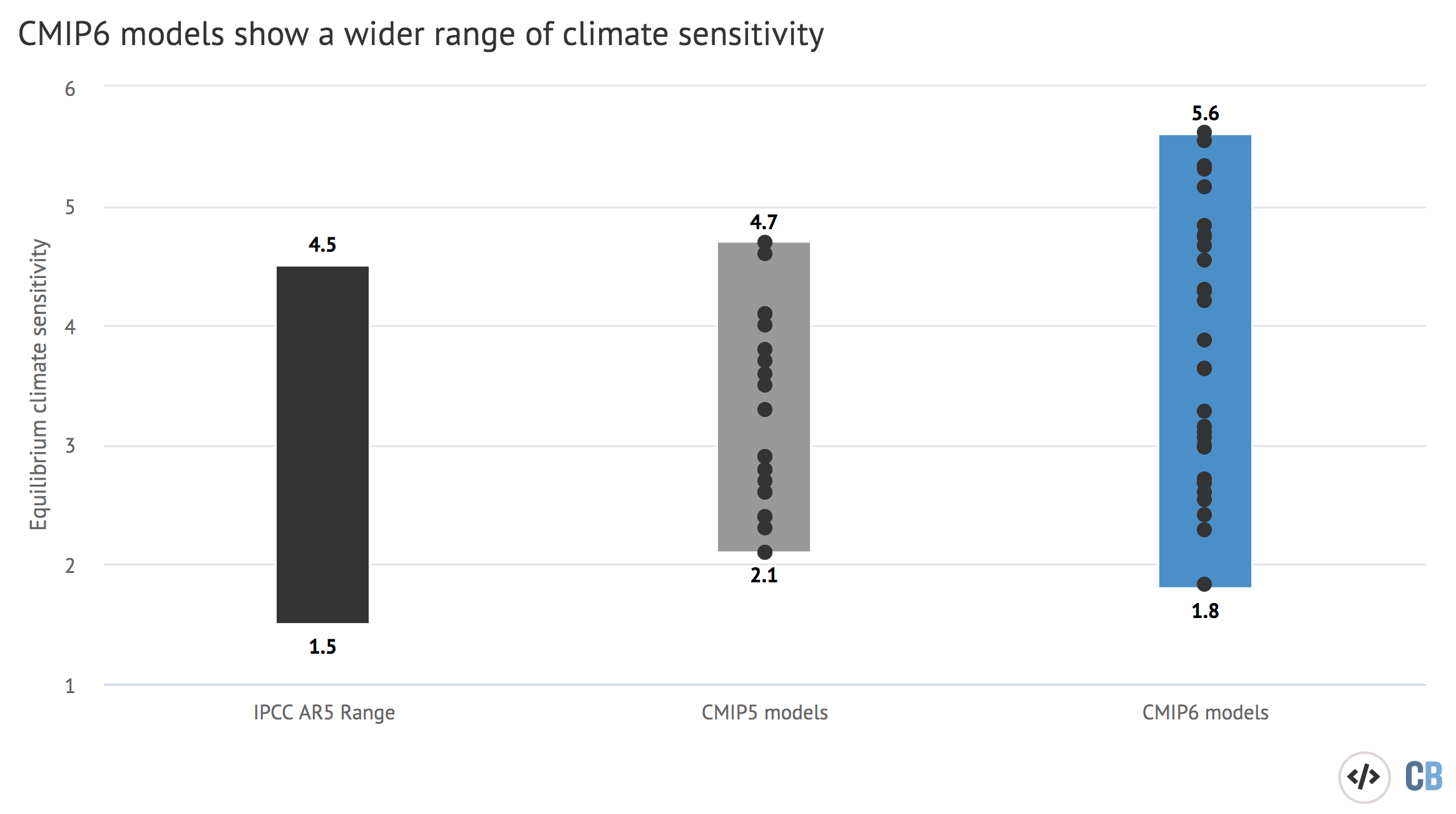Cold Water on Hot Models
-
-
Share
-
Share via Twitter -
Share via Facebook -
Share via Email
-
News headlines have recently warned about “troubling” new warming projections from climate models that are “running red hot.” In reality, these only represent a small subset of the new models currently being developed — most of which are not running notably “hot.” And many of the “hot” models do a relatively poor job of reproducing past temperature changes, an important test of model skill. Climate scientists use many different lines of evidence to estimate how sensitive the climate is to increasing greenhouse gas concentrations, and it is premature to conclude that climate sensitivity is likely higher than we previously thought.
Climate modeling groups around the world are in the process of running the latest generation of climate models that will be featured in the upcoming 2021 IPCC 6th Assessment Report (AR6). These models are being run as part of the Coupled Model Intercomparison Project 6 (CMIP6). Results from only around 30 CMIP6 models have been published so far, of the 100 or so models expected to ultimately submit results.
While a subset of new models are showing much more warming than their predecessors, most models are not, and we should be cautious about overinterpreting these new results. A number of prominent climate scientists have expressed scepticism of the high-end values, arguing that they are inconsistent with other evidence that very high sensitivity outcomes are unlikely.
Many different lines of evidence — including climate models, historical temperatures, and paleoclimate data from the Earth’s past — inform our best estimates of how sensitive the climate is to increased atmospheric greenhouse gas concentrations. These suggest that our best estimate of how much the earth will warm if we double atmospheric CO2 is probably around 3C (+/- 1.5C) rather than the 5C found in the highest sensitivity CMIP6 models.
This does not mean that we should dismiss these new higher sensitivity models; they show that there is a chance of some very-high-end warming outcomes that we should not ignore. At the same time, we should acknowledge that these new estimates remain outliers both among the 30 CMIP6 models available so far and among the wider set of climate sensitivity estimates in the scientific literature.
CMIP6 Includes Some Higher Sensitivity Models
Climate sensitivity refers to how much the world will warm as concentrations of atmospheric greenhouse gases rise. It is a value that emerges from physical and biogeochemical simulations within climate models; it is not explicitly set by modellers. Its most common measure is equilibrium climate sensitivity (ECS), which quantifies the expected long-term warming after a doubling of atmospheric CO2 concentrations, a long-standing benchmark in climate science.
Since the late 1970s the range of ECS has been thought to lie somewhere between 1.5C and 4.5C, with a central estimate of around 3C. This was the “likely” range of climate sensitivity given in the 2013 IPCC Fifth Assessment Report (AR5), and the last generation of climate models (from CMIP5) showed a similar range of 2.1C to 4.7C.
But the new CMIP6 results show an wider overall range of climate sensitivity than was found in CMIP5, with one model featuring a climate sensitivity as low as 1.8C and a number showing climate sensitivities well above 5C.
The figure below shows the range of climate sensitivity in the AR5, CMIP5, and the new CMIP6 models. Each black dot represents the ECS values for an individual climate model. The new CMIP6 results are still coming in, with only 30% of the models reporting so far, so this range may change in the future.

The average climate sensitivity of CMIP6 models is also somewhat higher so far — 3.8C compared to 3.2C. As more models have come in, however, the average sensitivity of CMIP6 models has fallen. This may reflect a bias toward faster reporting by the more well-funded and staffed modeling groups that also likely made the largest changes between CMIP5 and CMIP6. As the remaining 70 models are released, the average climate sensitivity may well move closer to that of CMIP5.
But whatever the values of the remaining 70 models, CMIP6 will include some sensitivity estimates that significantly exceed any from CMIP5. The figure below shows the ECS from 30 CMIP6 models that currently have values available. The subset of models with ECS values higher than any found in CMIP5 are shown in yellow, while those consistent with the CMIP5 sensitivity range are shown in blue.

Nine of the 30 CMIP6 models currently available have a climate sensitivity higher than any CMIP5 models. These extreme models have pulled up the average, despite the fact that nearly half (13) have a climate sensitivity lower than the 3.2C average of CMIP5.
Researchers are currently looking into what is driving these high ECS values in some models. In a number of cases, it appears to be due to their improved representation of clouds and aerosols. For example, how models treat supercooled clouds (below freezing but still liquid) in the Southern oceans can make a big difference.
Many high sensitivity models have poor hindcasts
Climate models provide both projections of future warming and “hindcasts” of past temperatures. These hindcasts can be used as a tool to evaluate the performance of models, though historical temperatures are only one of many hundreds of different variables that climate models generate.
A number of the higher sensitivity models in CMIP6 have had trouble accurately “hindcasting” historical temperatures. Some show almost no warming over the 20th century — with cooling effects from aerosols almost completely counterbalancing rising atmospheric greenhouse gas concentrations — followed by a massive warming spike in recent decades. Others show too much warming over the past 150 years.
The figure below, from a new paper currently under review in the journal Earth System Dynamics, shows how the new CMIP6 model runs (colored lines) compared to observed historical temperatures (black lines). Models are colored based on their transient climate response (TCR) — a measure of climate sensitivity based that tends to be a better predictor of shorter-term climate responses than long-term equilibrium sensitivity.

High sensitivity models (in red) generally show more warming than observations over the last three decades, while those with a TCR of around 2.2C or less (in blue) tend to agree much better with observations. High ECS models tend to have high TCR, though the two measures of sensitivity are not perfectly correlated. In this case, all the models in the figure with an ECS above 5C (except for one — CESM2) also have a TCR value above 2.5C.
The ability to accurately predict historical temperatures is not a perfect test of model performance. For example, natural variability in the real world – such as La Nina or El Nino events – do not happen at the same time in climate models. These different “phases” of natural variability can influence how well models perform compared to observations over a decade or two. However, the mismatches between some high sensitivity models and observations are large enough and occur over long enough periods of time that they are unlikely to only be due to natural variability.
Poor hindcast performance is not a reason to rule out models entirely; many models that poorly match historical temperatures may compare more favorably across other climate variables such as cloud cover, top of atmosphere radiation fluxes, precipitation patterns, etc. But it does provide a note of caution about these new results.
Climate sensitivity should be based on multiple lines of evidence
Models are an important way that climate scientists estimate sensitivity, but they’re far from the only one. Sensitivity can also be estimated by applying emergent constraints to climate models — for example, identifying which models perform better on observable metrics such as cloud behavior that are correlated with climate sensitivity. Sensitivity can also be inferred from the instrumental temperature records over the past 150 years, as well as from climate proxy records from the Earth’s more distant past — periods such as recent ice ages, the Pliocene, or the Eocene.
By considering these multiple lines of evidence — rather than just a subset of the latest climate models — we get a more nuanced view of climate sensitivity than if we only rely on the latest climate models. The figure below shows the climate sensitivity range inferred from various types of studies, based on a review of 142 estimates published between 2001 and 2018.

The bars show the median of the high, low, and best-estimate of climate sensitivity across 22 model-based studies, 31 using emergent constraints, 40 instrumental estimates, 31 paleoclimate estimates, and 18 using a combination of approaches. Only a third of studies suggested that an ECS of 5C or above was within the uncertainty range, and only six of the 142 studies suggested that the most likely ECS value was 5C or above. More broadly, there are relatively few studies that do not rely on climate models — such as those using instrumental temperatures or paleoclimate proxies — that support estimates of ECS exceeding 5C.
These new 5C ECS models should remind us that large uncertainties (and long tails of risk) remain, but they do not by themselves overturn the long-term consensus that climate sensitivity is likely somewhere around 3C (+/- 1.5C) per doubling of CO2.

